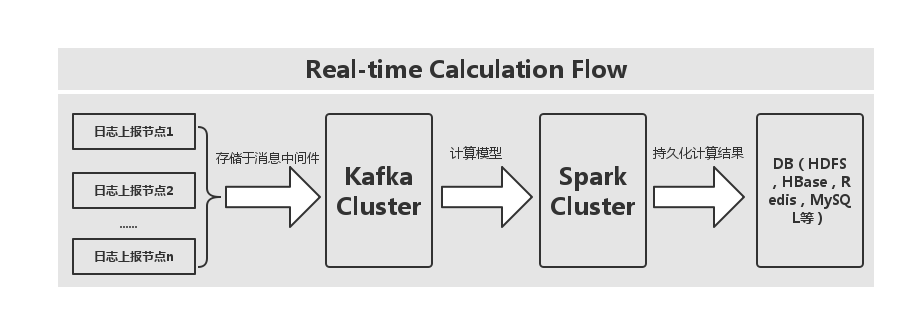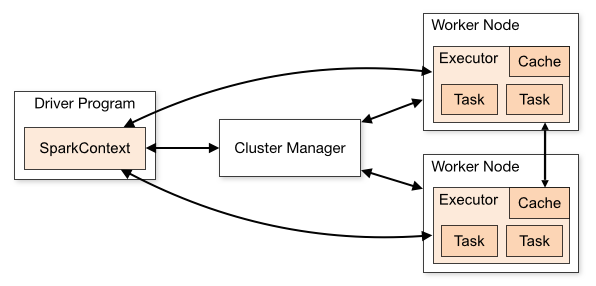本篇博客的主要内容并不是讲述 Spark 的工作原理和计算方法,多的内容,这里笔者就不再赘述,若是大家想详细了解 Spark 的相关内容,可参考官方文档。[参考地址]
接下来,笔者为大家呈现本案例的一个实现流程图,如下图所示:

通过上图,我们可以看出,首先是采集上报的日志数据,将其存放于消息中间件,这里消息中间件采用的是 Kafka,然后在使用计算模型按照业务指标实现相应的计算内容,最后是将计算后的结果进行持久化,DB 的选择可以多样化,这里笔者就直接使用了 Redis 来作为演示的存储介质,大家所示在使用中,可以替换该存储介质,比如将结果存放到 HDFS,HBase Cluster,或是 MySQL 等都行。这里,我们使用 Spark SQL 来替换掉 Storm 的业务实现编写。
3.实现
在介绍完上面的内容后,我们接下来就去实现该内容,首先我们要生产数据源,实际的场景下,会有上报好的日志数据,这里,我们就直接写一个模拟数据类,实现代码如下所示:
|
1
2
3
4
5
6
7
8
9
10
11
12
13
14
15
16
17
18
19
20
21
22
23
24
25
26
27
28
29
30
31
32
33
34
35
36
37
38
39
40
41
42
43
44
45
46
47
48
49
50
51
52
53
54
55
56
57
58
59
60
61
62
63
64
65
66
67
68
69
70
71
72
73
74
75
76
77
78
79
80
81
82
83
84
85
86
87
88
89
90
91
92
93
94
95
96
97
|
object
KafkaIPLoginProducer {
private
val
uid
=
Array(
"123dfe"
,
"234weq"
,
"213ssf"
)
private
val
random
=
new
Random()
private
var
pointer
=
-
1
def
getUserID()
:
String
=
{
pointer
=
pointer +
1
if
(pointer >
=
users.length) {
pointer
=
0
uid(pointer)
}
else
{
uid(pointer)
}
}
def
plat()
:
String
=
{
random.nextInt(
10
) +
"10"
}
def
ip()
:
String
=
{
random.nextInt(
10
) +
".12.1.211"
}
def
country()
:
String
=
{
"中国"
+ random.nextInt(
10
)
}
def
city()
:
String
=
{
"深圳"
+ random.nextInt(
10
)
}
def
location()
:
JSONArray
=
{
JSON.parseArray(
"["
+ random.nextInt(
10
) +
","
+ random.nextInt(
10
) +
"]"
)
}
def
main(args
:
Array[String])
:
Unit
=
{
val
topic
=
"test_data3"
val
brokers
=
"dn1:9092,dn2:9092,dn3:9092"
val
props
=
new
Properties()
props.put(
"metadata.broker.list"
, brokers)
props.put(
"serializer.class"
,
"kafka.serializer.StringEncoder"
)
val
kafkaConfig
=
new
ProducerConfig(props)
val
producer
=
new
Producer[String, String](kafkaConfig)
while
(
true
) {
val
event
=
new
JSONObject()
event
.put(
"_plat"
,
"1001"
)
.put(
"_uid"
,
"10001"
)
.put(
"_tm"
, (System.currentTimeMillis /
1000
).toString())
.put(
"ip"
, ip)
.put(
"country"
, country)
.put(
"city"
, city)
.put(
"location"
, JSON.parseArray(
"[0,1]"
))
println(
"Message sent: "
+ event)
producer.send(
new
KeyedMessage[String, String](topic, event.toString))
event
.put(
"_plat"
,
"1001"
)
.put(
"_uid"
,
"10001"
)
.put(
"_tm"
, (System.currentTimeMillis /
1000
).toString())
.put(
"ip"
, ip)
.put(
"country"
, country)
.put(
"city"
, city)
.put(
"location"
, JSON.parseArray(
"[0,1]"
))
println(
"Message sent: "
+ event)
producer.send(
new
KeyedMessage[String, String](topic, event.toString))
event
.put(
"_plat"
,
"1001"
)
.put(
"_uid"
,
"10002"
)
.put(
"_tm"
, (System.currentTimeMillis /
1000
).toString())
.put(
"ip"
, ip)
.put(
"country"
, country)
.put(
"city"
, city)
.put(
"location"
, JSON.parseArray(
"[0,1]"
))
println(
"Message sent: "
+ event)
producer.send(
new
KeyedMessage[String, String](topic, event.toString))
event
.put(
"_plat"
,
"1002"
)
.put(
"_uid"
,
"10001"
)
.put(
"_tm"
, (System.currentTimeMillis /
1000
).toString())
.put(
"ip"
, ip)
.put(
"country"
, country)
.put(
"city"
, city)
.put(
"location"
, JSON.parseArray(
"[0,1]"
))
println(
"Message sent: "
+ event)
producer.send(
new
KeyedMessage[String, String](topic, event.toString))
Thread.sleep(
30000
)
}
}
}
|
上面代码,通过 Thread.sleep() 来控制数据生产的速度。接下来,我们来看看如何实现每个用户在各个区域所分布的情况,它是按照坐标分组,平台和用户ID过滤进行累加次数,逻辑用 SQL 实现较为简单,关键是在实现过程中需要注意的一些问题,比如对象的序列化问题。这里,细节的问题,我们先不讨论,先看下实现的代码,如下所示:
|
1
2
3
4
5
6
7
8
9
10
11
12
13
14
15
16
17
18
19
20
21
22
23
24
25
26
27
28
29
30
31
32
33
34
35
36
37
38
39
40
41
42
43
44
45
46
47
48
49
50
51
52
53
54
55
56
57
58
59
60
61
62
63
64
65
66
67
68
69
70
71
72
73
74
75
76
77
78
79
80
81
82
83
84
85
86
87
88
89
90
91
92
93
94
95
96
97
98
99
100
101
102
103
104
105
106
107
108
109
110
111
112
113
114
115
116
117
118
119
120
121
122
123
124
125
|
object
IPLoginAnalytics {
def
main(args
:
Array[String])
:
Unit
=
{
val
sdf
=
new
SimpleDateFormat(
"yyyyMMdd"
)
var
masterUrl
=
"local[2]"
if
(args.length >
0
) {
masterUrl
=
args(
0
)
}
// Create a StreamingContext with the given master URL
val
conf
=
new
SparkConf().setMaster(masterUrl).setAppName(
"IPLoginCountStat"
)
val
ssc
=
new
StreamingContext(conf, Seconds(
5
))
// Kafka configurations
val
topics
=
Set(
"test_data3"
)
val
brokers
=
"dn1:9092,dn2:9092,dn3:9092"
val
kafkaParams
=
Map[String, String](
"metadata.broker.list"
-> brokers,
"serializer.class"
->
"kafka.serializer.StringEncoder"
)
val
ipLoginHashKey
=
"mf::ip::login::"
+ sdf.format(
new
Date())
// Create a direct stream
val
kafkaStream
=
KafkaUtils.createDirectStream[String, String, StringDecoder, StringDecoder](ssc, kafkaParams, topics)
val
events
=
kafkaStream.flatMap(line
=
> {
val
data
=
JSONObject.fromObject(line.
_
2
)
Some(data)
})
def
func(iter
:
Iterator[(String, String)])
:
Unit
=
{
while
(iter.hasNext) {
val
item
=
iter.next()
println(item.
_
1
+
","
+ item.
_
2
)
}
}
events.foreachRDD { rdd
=
>
// Get the singleton instance of SQLContext
val
sqlContext
=
SQLContextSingleton.getInstance(rdd.sparkContext)
import
sqlContext.implicits.
_
// Convert RDD[String] to DataFrame
val
wordsDataFrame
=
rdd.map(f
=
> Record(f.getString(
"_plat"
), f.getString(
"_uid"
), f.getString(
"_tm"
), f.getString(
"country"
), f.getString(
"location"
))).toDF()
// Register as table
wordsDataFrame.registerTempTable(
"events"
)
// Do word count on table using SQL and print it
val
wordCountsDataFrame
=
sqlContext.sql(
"select location,count(distinct plat,uid) as value from events where from_unixtime(tm,'yyyyMMdd') = '"
+ sdf.format(
new
Date()) +
"' group by location"
)
var
results
=
wordCountsDataFrame.collect().iterator
/**
* Internal Redis client for managing Redis connection {@link Jedis} based on {@link RedisPool}
*/
object
InternalRedisClient
extends
Serializable {
@
transient
private
var
pool
:
JedisPool
=
null
def
makePool(redisHost
:
String, redisPort
:
Int, redisTimeout
:
Int,
maxTotal
:
Int, maxIdle
:
Int, minIdle
:
Int)
:
Unit
=
{
makePool(redisHost, redisPort, redisTimeout, maxTotal, maxIdle, minIdle,
true
,
false
,
10000
)
}
def
makePool(redisHost
:
String, redisPort
:
Int, redisTimeout
:
Int,
maxTotal
:
Int, maxIdle
:
Int, minIdle
:
Int, testOnBorrow
:
Boolean,
testOnReturn
:
Boolean, maxWaitMillis
:
Long)
:
Unit
=
{
if
(pool
==
null
) {
val
poolConfig
=
new
GenericObjectPoolConfig()
poolConfig.setMaxTotal(maxTotal)
poolConfig.setMaxIdle(maxIdle)
poolConfig.setMinIdle(minIdle)
poolConfig.setTestOnBorrow(testOnBorrow)
poolConfig.setTestOnReturn(testOnReturn)
poolConfig.setMaxWaitMillis(maxWaitMillis)
pool
=
new
JedisPool(poolConfig, redisHost, redisPort, redisTimeout)
val
hook
=
new
Thread {
override
def
run
=
pool.destroy()
}
sys.addShutdownHook(hook.run)
}
}
def
getPool
:
JedisPool
=
{
assert(pool !
=
null
)
pool
}
}
// Redis configurations
val
maxTotal
=
10
val
maxIdle
=
10
val
minIdle
=
1
val
redisHost
=
"dn1"
val
redisPort
=
6379
val
redisTimeout
=
30000
InternalRedisClient.makePool(redisHost, redisPort, redisTimeout, maxTotal, maxIdle, minIdle)
val
jedis
=
InternalRedisClient.getPool.getResource
while
(results.hasNext) {
var
item
=
results.next()
var
key
=
item.getString(
0
)
var
value
=
item.getLong(
1
)
jedis.hincrBy(ipLoginHashKey, key, value)
}
}
ssc.start()
ssc.awaitTermination()
}
}
/** Case class for converting RDD to DataFrame */
case
class
Record(plat
:
String, uid
:
String, tm
:
String, country
:
String, location
:
String)
/** Lazily instantiated singleton instance of SQLContext */
object
SQLContextSingleton {
@
transient
private
var
instance
:
SQLContext
=
_
def
getInstance(sparkContext
:
SparkContext)
:
SQLContext
=
{
if
(instance
==
null
) {
instance
=
new
SQLContext(sparkContext)
}
instance
}
}
|
我们在开发环境进行测试的时候,使用 local[k] 部署模式,在本地启动 K 个 Worker 线程来进行计算,而这 K 个 Worker 在同一个 JVM 中,上面的示例,默认使用 local[k] 模式。这里我们需要普及一下 Spark 的架构,架构图来自 Spark 的官网,[链接地址]

这里,不管是在 local[k] 模式,Standalone 模式,还是 Mesos 或是 YARN 模式,整个 Spark Cluster 的结构都可以用改图来阐述,只是各个组件的运行环境略有不同,从而导致他们可能运行在分布式环境,本地环境,亦或是一个 JVM 实利当中。例如,在 local[k] 模式,上图表示在同一节点上的单个进程上的多个组件,而对于 YARN 模式,驱动程序是在 YARN Cluster 之外的节点上提交 Spark 应用,其他组件都是运行在 YARN Cluster 管理的节点上的。
而对于 Spark Cluster 部署应用后,在进行相关计算的时候会将 RDD 数据集上的函数发送到集群中的 Worker 上的 Executor,然而,这些函数做操作的对象必须是可序列化的。上述代码利用 Scala 的语言特性,解决了这一问题。
4.结果预览
在完成上述代码后,我们执行代码,看看预览结果如下,执行结果,如下所示:
4.1 启动生产线程

4.2 Redis 结果预览

5.总结
整体的实现内容不算太复杂,统计的业务指标,这里我们使用 SQL 来完成这部分工作,对比 Storm 来说,我们专注 SQL 的编写就好,难度不算太大。可操作性较为友好。
转自:http://www.cnblogs.com/smartloli/p/5560897.html






















 被折叠的 条评论
为什么被折叠?
被折叠的 条评论
为什么被折叠?








